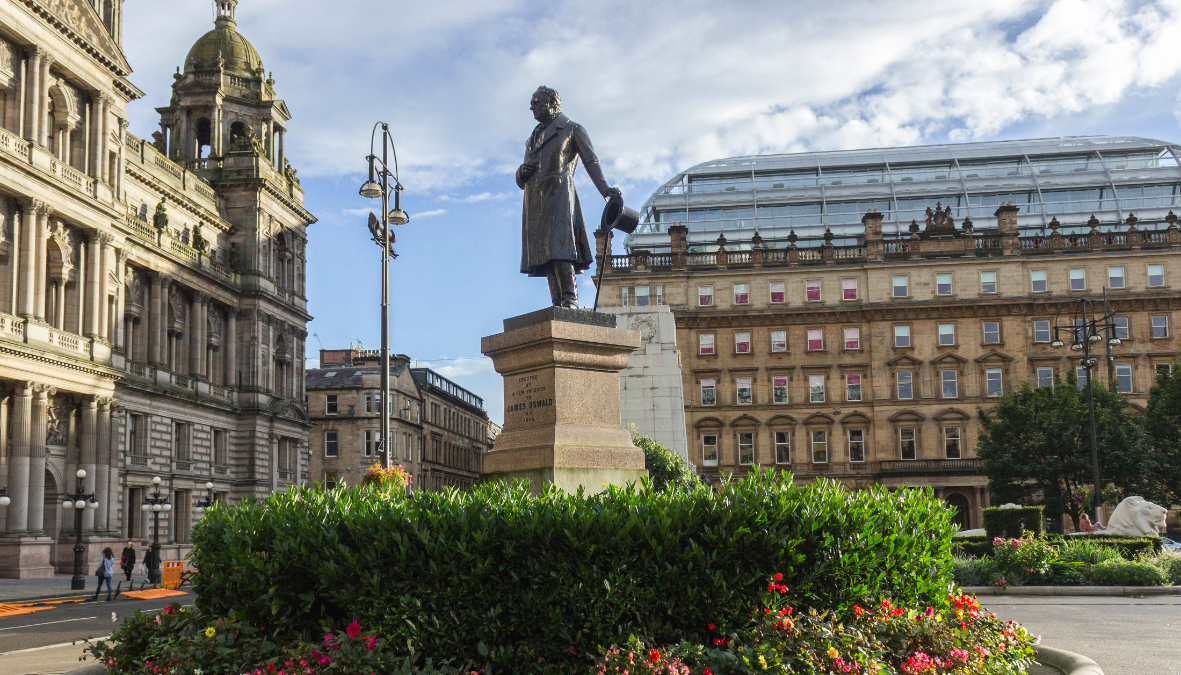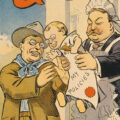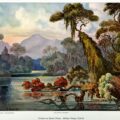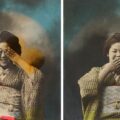A Stone in the Hat: Joseph Conrad and Neil Munro

In 1898, Joseph Conrad was considering returning to the sea. An Outcast of the Islands and Almayer’s Folly had been praised by critics but sales were poor; Conrad “…could not find his books on sale anywhere.‘’ In September, Conrad headed north, to Glasgow, in the hope of finding a captaincy and returning to the sea.
Was Conrad genuinely considering giving up writing? One recent biographer makes no mention of the trip to Glasgow, which suggests he didn’t think Conrad was serious. While in Glasgow, Conrad met up with Glasgow-based writer and journalist Neil Munro, whose recent collection of short stories he had admired. Munro was also keen on Conrad’s writing; just a few weeks before their meeting he had written in a newspaper column “A generation hence… we shall waken up to find that Joseph Conrad has been the most wonderful writer of the sea English literature has produced.”
Munro and Conrad dined in the Bath Street home of Dr John McIntyre, a pioneer of X-ray photography. It was a high-tech evening, partly spent listening to Conrad’s pianist compatriot Paderewski on a phonograph (the Spotify of its day), and “we had our hands X-rayed and before we left for a stroll through the sleeping city which lasted till three AM we got the photograph prints of them.”
It is during this late walk through Glasgow that an irresistible episode probably took place, though Osborne suggests that it was during Conrad’s 1923 visit to Glasgow, when the ailing but now lionized Pole dined with Munro and other Scottish literary figures in the North British Hotel. The fullest description of the incident is given by Lesley Lendrum. The two men came to George Square, to the north-eastern corner and the statue of James Oswald. Oswald had been a local supporter of the 1832 Reform Bill and he later served as an MP. His statue still stands where Conrad and Munro encountered it, his top hat held in his outstretched left hand. Small boys used to try to throw stones into the hat. This doesn’t happen now—today’s small boys are presumably better-behaved than the Victorian generation. Munro “…was quite capable of inventing ancient Glasgow superstitions at a moment’s notice” and informed Conrad that he would become an honorary Glaswegian if he managed to land a stone in the hat. After several tries, he managed to do so. It’s worth stressing that they had tippled a good deal; Conrad later wrote to Edward Garnett about the 1898 evening and in so doing coined a fine euphemism; “We foregathered very much indeed.” Surely, then, it was near the end of this drunken episode, roaming the streets of Glasgow, that they tossed the stones, not when in their old age 25 years later.
After seeing Conrad safely into the St Enoch Hotel, Munro had to walk several miles to his Southside home, having missed the last train. He didn’t arrive until 5am.
The two men kept in touch afterwards, but Conrad’s visit to Glasgow was a failure. He told Edward Garnett, “Nothing decisive happened in Glasgow.” Conrad must have been better known as a writer than he feared, for he later blamed his literary reputation for his failure to gain a ship; ‘This confounded literature has ruined me entirely’ he wrote to another Scottish friend, RB Cunninghame Graham, that November.
For English letters it’s as well that Conrad didn’t return to the sea. He remains a towering literary figure, but, outside Scotland, Munro is less well known. The friendship with Munro has puzzled some Conrad scholars.
Lesley Lendrum is the best source for biographical information about Munro; much of the following is drawn from her work. Neil Munro was born, the illegitimate son of a kitchen maid, in Inveraray, Argyll, in 1863. He grew up bilingual in English and Gaelic, and moved to Glasgow when he was 18; he drifted into journalism and began submitting poems and short stories to the press. Blackwood’s Magazine became excited about his short stories and The Lost Pibroch and Other Sheiling Stories appeared in 1896.
In these stories, Munro tackled Gaelic culture and history, attempting to reflect Gaelic speech rhythms in English (“Its story was the story that’s ill to tell—something of the heart’s longing and the curious chances of life”), but his fiction is earthy and often tragic. The stories show little of the wistful Celtic Twilight movement (current at the time) and perhaps a more apt comparison is with Hardy’s Wessex short stories. The Lost Pibroch sold well in England as well as in Scotland.
Munro’s first novel was John Splendid, a historical tale set during Montrose’s campaigns (“And splendid indeed it is,” wrote Conrad to Munro in November 1898). His final completed novel, The New Road, was another historical piece, this time set before the 1745 Jacobite rising; it’s usually regarded as his best and was adapted for BBC television as recently as 1974. Superficially another exciting Highland chase novel after Stevenson’s Kidnapped, The New Road is a searching, thoughtful exploration of how ancient, martial societies decline and break up. The rebellious Highlanders will be tamed not just by force of arms, but by trade and goods, by a money economy and cultural dilution. The new road, Wade’s attempt to subjugate the Highlands, will succeed not just because it enables soldiers to move about more efficiently, but because the road will be exploited by commercial interests, traders, merchants and the money economy. It’s a historical novel that draws powerfully on economic approaches to history.
Essentially, The New Road follows the conventions of Kidnapped; a wise old Highland head (Ninian Campbell) and a younger companion, Aeneas McPherson, take to the heather while on the run and have various adventures. However, besides the economic symbolism of the new road, like John Splendid it reverses the viewpoint of many Scottish historical romances. Scott’s Waverley and The Heart of Midlothian and Rob Roy keep the focus with the 17th century Stuart cause and with the 18th century Jacobites. So, generally, does John Buchan in his historical novels, as did DK Broster in her Jacobite trilogy. So also, in literary diminishing returns, does Diana Gabaldon in her Outlander series.
Munro was raised in Inveraray, the home of the Campbells of Argyll, the traditional leaders of the Protestant, Covenanting, Hanoverian side in the Highlands. And so in Munro’s historical novels the camera is always positioned among the Campbells. Munro is not necessarily on their side, but the viewpoint remains with them and so they are portrayed with more understanding than in other works. An interesting exercise is to read John Splendid, which is set during the 1640s wars of the Marquis of Montrose, and then Scott’s A Legend of the Wars of Montrose which fictionalizes exactly the same events. Scott’s camera is always with Montrose and the Royalist army. Munro tells the tale from the other side, but is arguably more understanding about the motivations of the Royalists than is Scott about the Covenanters.
It’s worth mentioning that in Kidnapped, which, as we’ve seen, was very much the template for The New Road, Stevenson attempted something more sophisticated than telling the tale from one side of the divide; rather, his two leading characters come from and represent the opposing sides. Stevenson allows them to show forth the positive qualities of their respective communities; David Balfour the stolid, faithful, learned and brave protestant Whig, heir of the Covenanting tradition; Alan Breck, the flamboyant, dashing, boastful and endearing Roman Catholic Jacobite. In a healing touch, Stevenson shows that good people from opposing viewpoints can recognize each other’s strengths and become friends despite their differences. Perhaps we need a Kidnapped for the social media Trump/Brexit era.
Munro published eight novels between 1898 and 1914, but remained a full-time journalist. He was married with, eventually, six children surviving to adulthood and he juggled journalism – including the editorship of the Glasgow Evening News—and other writing, mindful of the number of mouths his pen had to feed. Hugh MacDiarmid, in his uncompromising series, Contemporary Scottish Studies, wrote of Munro “He has consistently served two Gods—and has not succeeded in avoiding the consequences of a divided allegiance.” This is one of MacDiarmid’s kinder comments in the series, almost praise by his standards.
In Munro’s regular newspaper columns he would often use recurring fictional characters to populate short humorous sketches. Three of these cycles of sketches eventually were collected in books of their own. Erchie, My Droll Friend was a comic Glaswegian worthy, while Jimmy Swan was a commercial traveller. However, his tales of the comical adventures of the crew of the Clyde coastal puffer The Vital Spark, collected in The Vital Spark, In Highland Harbours with Para Handy and Hurricane Jack of the Vital Spark were destined to be his most successful works. A complete collection of the three volumes together with previously unpublished sketches was published in 2002
These comic sketches—always journalism and never really “short stories”—were published under the pseudonym “Hugh Foulis,” though everyone was in on the secret. The runaway success of the Vital Spark stories became an embarrassment, like the popularity of the Sherlock Holmes stories to Conan Doyle. However, he had tapped into something real and enduring, particularly in the vainglorious but lovable figure of the boat’s skipper, Para Handy. These days, if English readers have been exposed to Munro at all, it’s through the three generations of the BBC sitcom based on Munro’s characters, with, successively, Duncan MacRae, Roddy MacMillan and Gregor Fisher as Para Handy. Additionally, while the credits of the 1954 Ealing comedy The Maggie make no mention of Munro or The Vital Spark, no-one who has read the stories can doubt where the idea came from. The novelization of the film reads like the full-length Para Handy novel Munro never wrote.
Neil Munro died in 1930. He had enjoyed a happy and contended marriage and family life, which are not usually conducive to prolonged fame. His work remained popular in Scotland, though, and the Para Handy stories have never been out of print. In more recent times, Munro has started to attract critical attention—curiously, there is a lengthy tradition of academic study of his works in Germany. His major novels and short story collections returned to print during the 1990s. His granddaughter, Lesley Lendrum, published a biography—the first—in 2004.
Some in England are unaware of this critical shift. One Conrad scholar, JH Stape, was clearly puzzled by Conrad’s meetings with Munro, whom he describes as “A now forgotten journalist and a writer of Scottish fiction [who] had the popular touch and reached a wide audience.” Stape also dismisses John Splendid as “unreadable now.”
I suspect Stape was unaware that Munro was, indeed, the author of the Para Handy stories, or that the novels had returned to print. Even so, it’s a difficult line for Conrad scholars to tread if they insist on dismissing Munro; Conrad clearly not only remained a good friend, but continued to have a high regard for Munro’s writing.
While there is some doubt about the date of Munro and Conrad’s adventures in George Square, as I have pointed out already I think the probabilities are with 1898 rather than 1923, but it is a difficult event to source; both Conrad and Munro wrote about other aspects of the 1898 meeting, but never about the stone-throwing. If it became known at all, it seems to have been owing to George Blake, Clydeside novelist and journalist colleague of Munro (cited by both House and Lendrum). Neil Munro’s diary is a sketchy record of meetings and travels from the 1880s to 1916, but the encounter with Conrad is not mentioned, though the week before he made a humdrum entry remarking “Sold Lipton shares at 24/- premium”! The stone-throwing has become “Munro folklore” but it certainly happened; Blake was a good friend of Munro’s and would have often heard the story of the 1898 foregathering. Taking the incident as a real one, I’d suggest it surprises us because we see Conrad, usually seen as a rather sombre figure, indulging in drunken juvenile japery.
Munro was an exceptional and hard-working exponent of journalism. We have perhaps forgotten how influential print journalists could once be, and the freedom with which they could approach their trade. Today’s broadsheet newspapers are often full of what-I-reckon columnists with little to say and little evidence for what they do say, but the columnist of the past had a much wider remit. Munro wrote all kinds of journalism, and many columns, some with a byline, some without, some with a pseudonym. His Jimmy Swan, Erchie and Para Handy “stories” were journalism, but they were journalism with creative imagination applied. Other, better known writers who approached columns in this way include SJ Perelman and, more recently in the UK, Alan Coren and Armando Ianucci. Most of Munro’s pieces were written to address issues in the local or national news but the characters, situation or dialogue are sufficient to ensure that all three—but especially Para Handy—can still be read with enjoyment today.
The Grand Old Man Comes Down is an Erchie story that tackles the issue of public statuary. Erchie tells us that (and here I have translated the dialogue from Munro’s Glaswegian into Standard English; I feel rather guilty about this) “Statues nowadays are like comic songs; they go out of fashion awfully quickly. Nobody looks at them after they’re more than a year in position.”
Erchie, or, rather, Munro, goes on to say, “The only one in George Square that attracts attention now is Mr Oswald with the top hat. It’s never occurred to anybody to put a lid on the hat to keep the boys from popping stones in it.” Here is the nearest Munro comes to writing about his nocturnal adventures with Conrad; perhaps he is recalling the 1898 foregathering and looking forward to Conrad’s second visit to Glasgow.
Erchie goes on to describe a future where statues will be cast on wheels so that they can be moved about to different locations in the city, thereby never losing their novelty. An idea whose absurdity is worthy of Alan Coren or Monty Python, yet in the era where BLM has shown us that we must interrogate the history of statues, I have heard considerably worse suggestions.
I hope this essay will encourage some readers unfamiliar with his work to explore the writings of Neil Munro. John Splendid and especially The New Road are telling and insightful historical novels while his short story collections The Lost Pibroch and Jaunty Jock, though very much of their time, are serious and brooding works (no wonder Joseph Conrad liked them, then). And finally, of course, Munro’s collected journalism contains many gems, not least of them the collected Para Handy stories. They may not be his most accomplished literary work, but they are nonetheless some kind of mirror to a certain type of Scottishness and it’s unlikely that they will ever be out of print. Munro died in 1930, but is a long way from being “forgotten,” whatever some Conrad scholars may suggest.
About David McVey
David McVey lectures at New College Lanarkshire in Scotland. He has published over 120 short stories and a great deal of non-fiction that focuses on history and the outdoors. He enjoys hillwalking (ie, hiking), visiting historic sites, reading, watching telly (ie, TV), and supporting his home-town football (ie, soccer) team, Kirkintilloch Rob Roy FC.





